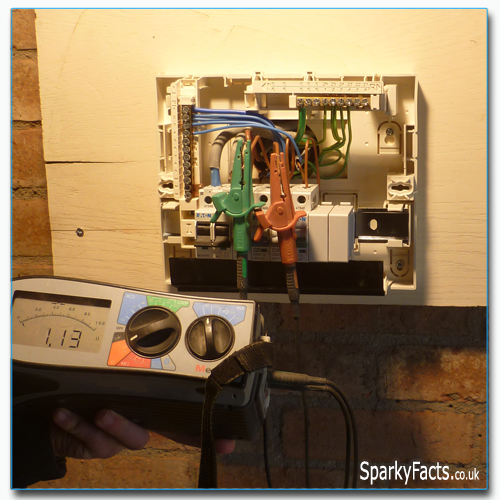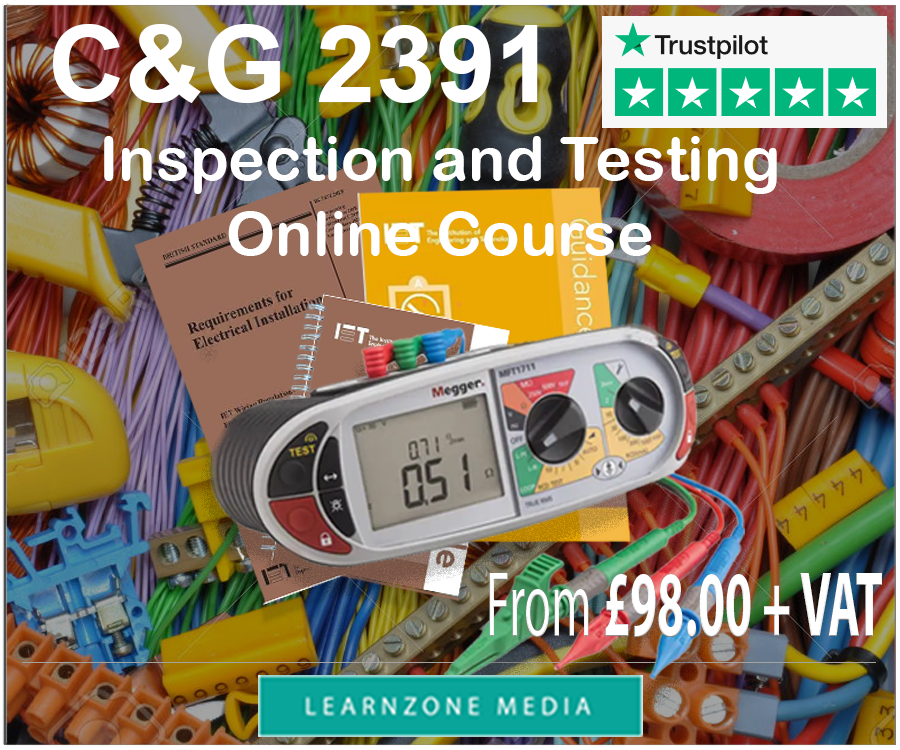Electrical Ring Circuit Inspection and Testing
The purpose of this test is to ensure that the cables form a complete ring without interconnections between the wires, and the polarity is correct on all outlets.
The best way to do a ring circuit test is with the help of a Resistance Tester or with the Low Reading Ohm meter function of an Installation Tester such as the Megger 1553.
In order to understand this testing procedure you must be familiar with the ring circuit wiring arrangement. You can refresh your knowledge on the ring circuit here.
The Ring Circuit Test sequence:
![]() Before everything, a safe isolation procedure must be carried out.
Before everything, a safe isolation procedure must be carried out.
Step 1. Within the distribution board, remove the Line, the Neutral and the Earth conductors from its terminals. Since this is a ring circuit there will be two of each in the same terminal.
Step 2. Select the low reading ohm meter function and null the tester.

Step 3. Measure between Line to Line to get the reading for “r1”

Step 4. Measure between Neutral to Neutral to get the reading for “rn”

Step 5. Measure between Earth and Earth to get the reading for “r2”

Step 6. Connect the first (outgoing) Line to the second (incoming) Earth and connect the second (incoming) Line to the first (outgoing) Earth (if you cannot see which one is the incoming or the outgoing conductor, just make guess, the testing will show whether you are correct or not).

Step 7. Using the low reading ohm meter, test between Line and Earth on every outlet on the ring circuit. The highest reading is the (R1+R2) for the circuit. The readings at each of the sockets wired on the ring should be very similar and the value should be according to this formula: (r1 +r2)/4. Every time the measured value is deviating by more than 0.5 ohms, the connection at the accessory terminals should be investigated.


Step 8. Remove the cross connection between the Line and Earth conductors and cross connect the Line and Neutral conductors instead (L1 to N2 and L2 to N1).

Step 9. Test between Line and Neutral on every outlet on the ring circuit. The readings at each of the sockets wired on the ring will be very similar and the value should be according to this formula: (r1 +rn)/4. Every time the measured value is deviating by more than 0.5 ohms, the connection at the accessory terminals should be investigated.
After these steps you can return the Line, Neutral and Earth conductors back in to its terminals within the distribution board.
The Inspection and Testing C&G 2391 practical exams
Do not forget to record the (R1+R2) value on the Schedule of Test Results.
Next we move on to Insulation Resistance testing.
Important things to remember:
![]() In a situation when it is not apparent which leg of the ring circuit is the incoming and which one is the outgoing (like the case with single core cables) the tester can only make a guess. The readings taken from every socket or accessory within the ring circuit, will show whether the guess was correct or not. If the readings are progressively increasing in value towards the middle of the ring circuit, and decline in value towards the end - the guess was wrong. The value of the reading should be the same everywhere and within 0.5 ohms of the calculated value.
In a situation when it is not apparent which leg of the ring circuit is the incoming and which one is the outgoing (like the case with single core cables) the tester can only make a guess. The readings taken from every socket or accessory within the ring circuit, will show whether the guess was correct or not. If the readings are progressively increasing in value towards the middle of the ring circuit, and decline in value towards the end - the guess was wrong. The value of the reading should be the same everywhere and within 0.5 ohms of the calculated value.
![]() In real life situations there could be bonding conductors going to some or all of the accessories on the ring circuit (e.i.: bonding of metallic conduit) which will greatly decrease the measured value of (R1+R2).
In real life situations there could be bonding conductors going to some or all of the accessories on the ring circuit (e.i.: bonding of metallic conduit) which will greatly decrease the measured value of (R1+R2).
![]() It is common that there are spurs on the ring circuit supplying additional sockets or other accessories. The measured value for (R1 + R2) will be higher for these spurs than the values calculated.
It is common that there are spurs on the ring circuit supplying additional sockets or other accessories. The measured value for (R1 + R2) will be higher for these spurs than the values calculated.
![]() Remember, that by doing these steps you will also confirm the correct polarity of the conductors, so there is no need to do polarity dead tests again.
Remember, that by doing these steps you will also confirm the correct polarity of the conductors, so there is no need to do polarity dead tests again.
![]() During the testing remember to constantly inspect the installation for faults and signs of damages.
During the testing remember to constantly inspect the installation for faults and signs of damages.





